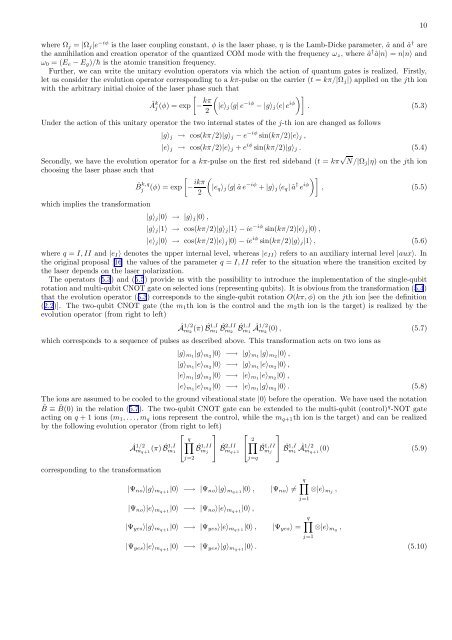Multiparticle Entanglement with Quantum Logic Networks
Multiparticle Entanglement with Quantum Logic Networks
Multiparticle Entanglement with Quantum Logic Networks
Create successful ePaper yourself
Turn your PDF publications into a flip-book with our unique Google optimized e-Paper software.
where Ω j = |Ω j |e −iφ is the laser coupling constant, φ is the laser phase, η is the Lamb-Dicke parameter, â and â † are<br />
the annihilation and creation operator of the quantized COM mode <strong>with</strong> the frequency ω z , where â † â|n〉 = n|n〉 and<br />
ω 0 = (E e − E g )/¯h is the atomic transition frequency.<br />
Further, we can write the unitary evolution operators via which the action of quantum gates is realized. Firstly,<br />
let us consider the evolution operator corresponding to a kπ-pulse on the carrier (t = kπ/|Ω j |) applied on the jth ion<br />
<strong>with</strong> the arbitrary initial choice of the laser phase such that<br />
[<br />
 k j (φ) = exp − kπ )]<br />
(|e〉 j 〈g| e −iφ − |g〉 j 〈e| e iφ . (5.3)<br />
2<br />
Under the action of this unitary operator the two internal states of the j-th ion are changed as follows<br />
|g〉 j → cos(kπ/2)|g〉 j − e −iφ sin(kπ/2)|e〉 j ,<br />
|e〉 j → cos(kπ/2)|e〉 j + e iφ sin(kπ/2)|g〉 j . (5.4)<br />
Secondly, we have the evolution operator for a kπ-pulse on the first red sideband (t = kπ √ N/|Ω j |η) on the jth ion<br />
choosing the laser phase such that<br />
[<br />
ˆB k,q<br />
j<br />
(φ) = exp − ikπ<br />
)]<br />
(|e q 〉 j 〈g| â e −iφ + |g〉 j 〈e q | â † e iφ , (5.5)<br />
2<br />
which implies the transformation<br />
|g〉 j |0〉 → |g〉 j |0〉 ,<br />
|g〉 j |1〉 → cos(kπ/2)|g〉 j |1〉 − ie −iφ sin(kπ/2)|e〉 j |0〉 ,<br />
|e〉 j |0〉 → cos(kπ/2)|e〉 j |0〉 − ie iφ sin(kπ/2)|g〉 j |1〉 , (5.6)<br />
where q = I, II and |e I 〉 denotes the upper internal level, whereas |e II 〉 refers to an auxiliary internal level |aux〉. In<br />
the original proposal [16] the values of the parameter q = I, II refer to the situation where the transition excited by<br />
the laser depends on the laser polarization.<br />
The operators (5.3) and (5.5) provide us <strong>with</strong> the possibility to introduce the implementation of the single-qubit<br />
rotation and multi-qubit CNOT gate on selected ions (representing qubits). It is obvious from the transformation (5.4)<br />
that the evolution operator (5.3) corresponds to the single-qubit rotation O(kπ, φ) on the jth ion [see the definition<br />
(2.2)]. The two-qubit CNOT gate (the m 1 th ion is the control and the m 2 th ion is the target) is realized by the<br />
evolution operator (from right to left)<br />
 1/2 1,I<br />
m 2<br />
(π) ˆB m 1<br />
ˆB2,II m 2<br />
10<br />
ˆB1,I m 1<br />
 1/2<br />
m 2<br />
(0) , (5.7)<br />
which corresponds to a sequence of pulses as described above. This transformation acts on two ions as<br />
|g〉 m1 |g〉 m2 |0〉 −→ |g〉 m1 |g〉 m2 |0〉 ,<br />
|g〉 m1 |e〉 m2 |0〉 −→ |g〉 m1 |e〉 m2 |0〉 ,<br />
|e〉 m1 |g〉 m2 |0〉 −→ |e〉 m1 |e〉 m2 |0〉 ,<br />
|e〉 m1 |e〉 m2 |0〉 −→ |e〉 m1 |g〉 m2 |0〉 . (5.8)<br />
The ions are assumed to be cooled to the ground vibrational state |0〉 before the operation. We have used the notation<br />
ˆB ≡ ˆB(0) in the relation (5.7). The two-qubit CNOT gate can be extended to the multi-qubit (control) q -NOT gate<br />
acting on q + 1 ions (m 1 , . . ., m q ions represent the control, while the m q+1 th ion is the target) and can be realized<br />
by the following evolution operator (from right to left)<br />
⎡ ⎤ ⎡ ⎤<br />
 1/2<br />
m q+1<br />
(π) ˆB 1,I<br />
m 1<br />
corresponding to the transformation<br />
⎣<br />
q∏<br />
j=2<br />
ˆB 1,II<br />
m j<br />
⎦ ˆB 2,II<br />
m q+1<br />
⎣<br />
2∏<br />
j=q<br />
ˆB 1,II<br />
m j<br />
|Ψ no 〉|g〉 mq+1 |0〉 −→ |Ψ no 〉|g〉 mq+1 |0〉 , |Ψ no 〉 ≠<br />
|Ψ no 〉|e〉 mq+1 |0〉 −→ |Ψ no 〉|e〉 mq+1 |0〉 ,<br />
|Ψ yes 〉|g〉 mq+1 |0〉 −→ |Ψ yes 〉|e〉 mq+1 |0〉 , |Ψ yes 〉 =<br />
⎦ ˆB 1,I<br />
m 1<br />
 1/2<br />
m q+1<br />
(0) (5.9)<br />
q∏<br />
⊗|e〉 mj ,<br />
j=1<br />
q∏<br />
⊗|e〉 mq ,<br />
|Ψ yes 〉|e〉 mq+1 |0〉 −→ |Ψ yes 〉|g〉 mq+1 |0〉 . (5.10)<br />
j=1

















